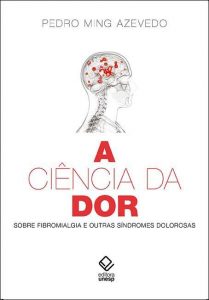Rheumatologist presents a manual of pain
Pedro Ming Azevedo presents a detailed account of persistent pain syndromes, with an emphasis on fibromyalgia

From time to time, we all feel pain. One bad night’s sleep and we wake up with a stiff neck that may annoy us for days. A tenser period at work and that occasional headache may turn into a chronic one. “When these pains persist for more than three consecutive months, a ‘persistent pain syndrome’ is installed. And when there is no specific physical factor behind it, we diagnose it as a ‘functional’ painful syndrome”- – explains rheumatologist Pedro Ming Azevedo, author of The Science of Pain: about fibromyalgia and other pain syndromes, recently published by Unesp Publishing House.
According to the doctor, the vast majority of us will eventually have a condition that may fit into one of these diagnoses during difficult periods of our lives. The birth of a child, job or family instabilities are classic triggering events, and they may help us start to understand what we are talking about: pain can be seen as a “natural” product of an “overload” created by the need to adapt to the demands of life. “However”, Azevedo explains, “at least 10% of the population feels some kind of functional pain that may persist after the end of such periods of greater stress, that may even start independently of them, or which are triggered by trivial, everyday events. When the pain is generalized, and not localized, it is called fibromyalgia.”
There is nothing “imaginary” about fibromyalgia, says Azevedo. The pain is intense, and not infrequently, it may be incompatible with a normal lifestyle. The ill-defined boundaries of this diagnosis, the absence of specific markers for the condition, and the ignorance about its origin and mechanisms often impose a routine of discredit and prejudice upon these individuals. Another difficulty lies on its treatment: it is clear that pills help at most in the short to medium term. As the beneficial effects of the pills disappear, patients feel the same pain again, and usually have to face their relatives’ impatience, as well as their doctors’ disdain. “Fibromyalgia is a complex condition, and it is caused by a different combination of factors in each patient”, Azevedo explains. “In order to treat it, it is crucial to consider these factors, the pillars that sustain us, and how we function. That’s how this book was born.”
The science of pain, as the title of the book indicates, uses science as its basis, goes a little further with the help of logic, and finally fills empty spaces with ideas and concepts established throughout our history”, writes Azevedo. The book comprises from neuroanatomy, neurophysiology, genetics and epidemiology to psychology, biology, and sociology. “Whenever scientific evidence exists, of course, they will be duly displayed. I can even imagine that the reader is more likely to be bothered by their excess, not the other way round.” The author also draws on his extensive experience in private practice and his training in cognitive-behavioral therapy.
In the first part of the book, which is devoted to pathophysiology, Azevedo clarifies the history of sensitivity syndromes: “a set of conditions in which the brain is too attentive, and reacts too strongly to the dangers and negative stimuli, as is the case with fibromyalgia and other persistent pain syndromes.”“. Then Azevedo proceeds to detail how doctors diagnose such syndromes, the history that surrounds the diagnosis and the attempts to devise subgroups in fibromyalgia (and how they can help us understand it). He also delves deeper into the genetic, neurological and psychosocial bases behind these conditions. In the second part of the book, Azevedo reviews evidences that support or refute the classical treatments for functional pain syndromes and suggests ways in which patients and health professionals can work around the difficulties that prevent social, psychological and behavioral changes that can effectively lead to an improvement in the long-term quality of life for such patients. In the last pages of the book, the reader finds tests and questionnaires that also evaluate its efficacy in achieving this goal.
“Based on my experiences in private practice, I disagree with the emphatic conclusions drawn by the authors of the guidelines: we do know a great deal about the causes of these syndromes, and at least for a significant number of these patients the ‘cure’ can be achieved”, Azevedo points out. “We must understand by ‘cure’ not only the ‘existential, philosophical and social’ changes, but also the medical and psychological changes that will enable them to live a fuller, happier life without dysfunctional pain.”
About the author

Pedro Ming Azevedo graduated in Medicine (1998) from the Faculty of Medicine of the University of São Paulo (USP), where he also specialized in Rheumatology (2002) and defended a PhD in Genetics of Autoimmune Diseases (2009). He conducted a further research on the theme during his the postdoctoral studies (2013) at the University of Auckland, in New Zealand. He currently teaches at the Rheumatology Department of the Evangelical Faculty of Paraná, supervises master’s and doctoral studies at the Institute of Medical Research (IPEM) of the same university, and teaches postgraduate courses at the Sociedade Beneficente Israelita Albert Einstein, in São Paulo. He is the author of several articles and book chapters, two of which are published in notable books on rheumatology (Rheumatology Textbook, by Marc C. Hochberg, and Kelley & Firestein’s Textbook of Rheumatology). Parallel to his academic career, he is in private practice as a physician and cognitive-behavioral therapist, which allows him to enrich his experience in the treatment of fibromyalgia patients as well as patients with other persistent pain syndromes.
Title: The Science of Pain: about fibromyalgia and other pain syndromes [A ciência da dor: sobre fibromialgia e outras síndromes dolorosas]
Author: Pedro Ming Azevedo
Number of pages:374
Format: 16 x 23 cm
ISBN:978-85-393-0742-5
Rights: worldwide free
